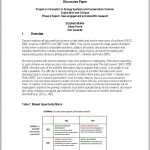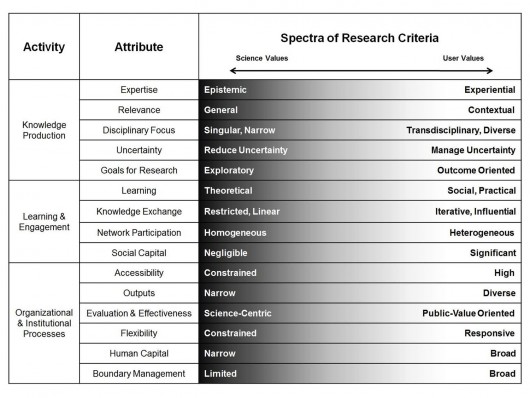User Engagement and Scientific Research
Program Areas – Science and Technology Policy, Complex Socio-technical Systems
Summary of the Typology
Elizabeth C. McNie, Adam Parris, Dan Sarewitz
Decision makers call upon and fund science to solve urgent problems, catalyze innovation, provide information that educates stakeholders, expand alternatives, clarify choices, and aid in formulating and implementing policy decisions. But linking science with action is difficult for a variety of reasons. One reason is that we tend to view and assess research in isolation from the context of its use, and simply in terms of whether it is “basic” or “applied.” This science-centric approach has great value in producing new knowledge, but tells us little about the potential value or usefulness of research in achieving the broader outcomes to which it is intended to contribute. Here we provide an approach that not only considers the isolated knowledge value of science, but also allows a consideration of the context of use, and particularly the engagement of intended users, in research that is intended to produce more useful information to contribute to solutions of societally-identified problems.
Improving the public value of research requires that we have a more complete view of research activities and expectations. The multi-dimensional research typology presented here can be used to inform deliberation about, and design and implementation of, research. The typology divides research into three general activities, each of which is subdivided into more specific attributes. These attributes are idealized, and each one is expressed in terms of a spectrum of value criteria ranging from strongly science-centric to strongly user-oriented. The left side of each spectrum represents research criteria focused on achieving ends internal to science—what we term “science values” (Meyer 2011). This research tends to be more disconnected from explicit consideration of the context of use and involvement of users, that is, science is treated as a closed system. The right side represents research criteria focused on achieving ends external to the research itself—what we term “user values.” Such research is open to engagement with actors other than the core researchers themselves, and is justified by the expectation of providing information and knowledge for various users and uses. A research activity is characterized in full by assessing where it lies on the spectrum of value criteria for the entire suite of attributes. Of course most research activities lie between the extremes. The typology allows this intermediate domain to be explored and characterized with attention to any or all of the fifteen research attributes. We intend it to be a heuristic device that can help inform and improve science-policy planning and decisions, and also assess the potential of existing projects, programs and institutions to achieve particular goals.
Activity 1: Knowledge Production
Knowledge addresses what is credible, who is credible, and what ways of creating knowledge are credible (Epstein 1995). Knowledge consists not just of facts but includes tacit skills and the wisdom of lived experiences, while acknowledging that freedom from bias and social influence is never entirely possible.
- Expertise: Who has the credibility to produce knowledge?
- Relevance: What is the source of relevance to solving the specific problem?
- Disciplinary Focus: How discipline-driven are the knowledge production activities?
- Uncertainty: How do researchers understand and address the problem of uncertainty in knowledge production?
- Goals for Research: Is the knowledge produced to provide insights into science itself, or into questions and problems outside of science?
Activity 2: Learning and Engagement
Learning requires information and a process of transformation in which behavior, knowledge, skills, goals, etc. are developed or changed. Social learning is contextual and iterative and requires systems thinking, communication, and negotiation. Learning becomes more difficult as problems become less structured and more complex.
- Learning: In what ways do the research outputs change the knowledge or decision-making system?
- Knowledge Exchange (“generating, sharing, and/or using knowledge through various methods appropriate to the context, purpose, and participants involved,” Fazey et al. 2013, p.19): To what extent, and how, is knowledge exchanged?
- Network Participation: Who participates in the knowledge network?
- Social Capital (relationships and “goodwill that others have toward us,” the effects of which flow from the “information, influence and solidarity such goodwill makes available,” Adler and Kwon 2002, p.18): How important is the development and deployment of social capital?
Activity 3: Organizational and Institutional Processes
The organization of work, research, incentives, and both formal and informal rules, all shape the process of work, knowledge production, and interactions between groups. Research processes and organizations are also subject to the same socio-technical considerations as other forms of work, albeit with different characteristics, norms, identities, and processes.
- Accessibility: How accessible to users are the researchers and their organizations or institutions?
- Outputs: How various are the research outputs?
- Evaluation and Effectiveness: What factors shape the evaluation of research?
- Flexibility: How easy is it to alter research to better respond to users’ needs, and changes in those needs?
- Human Capital: What kinds of skills and training are needed to do the research?
- Boundary Management (The boundary between science and society needs to be managed to accomplish two mutual goals: ensuring that research responds to the needs of users and assuring the credibility of science. Boundary work involves communicating between science and society, translating information, and mediating and negotiating across the boundary, Guston 2001): To what extent must efforts be made to actively manage the boundary?
The typology provides a framework to visualize the range of activities of a science project or several projects across a program or institution at a given time and over a period of years. Science managers can use the typology to help bring their expert judgment to bear on understanding the relations among (a) the complex attributes of research activities, (b) the expectations for and promises about the goals of science, and (c) the extent to which research activities are appropriately structured to advance desired societal outcomes. Applying the typology, or other rigorous methods of science policy assessment, across broad portfolios of science can support responsible decision making about science that supports public value.
Citations
Adler, P.S., Kwon, S.W. 2002. Social Capital: Prospects for a New Concept. The Academy of Management Review 27, 17-40.
Epstein, Steven. 1995. The Construction of Lay Expertise: AIDS Activism and the Forging of Credibility in the Reform of Clinical Trials. Science, Technology and Human Values 20 (4), 408-437.
Fazey, I. et al 2013. Knowledge Exchange: A Review and Research Agenda for Environmental Management. Environmental Conservation 40, 19–36.
Guston, David. 2001. Boundary Organizations in Environmental Policy and Science 26 (4), 399-408.
Meyer, Ryan. 2011. The Public Values Failures of Climate Science in the US. Minerva 49 (1), 47–70.
This project was supported by a grant from the David and Lucile Packard Foundation

